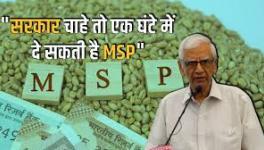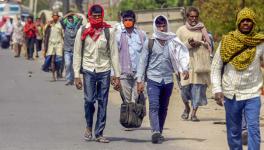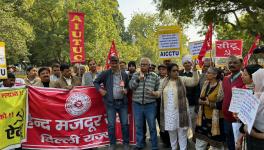Malwa Farmers and Farm Labourers Continue to Fight Multiple Battles

Photo by Tripta Narang.
On the occasion of Guru Nanak Jayanti, Prime Minister Modi announced his government’s decision to repeal the three farm laws that were to impact lives and livelihoods of people -- especially the very small and marginal farmers and the common people i.e. the consumers of farm produce. This is a big victory for the farmers protesting at the Delhi borders for a year now, braving the harsh winter, intense heat, and heavy rains as well as the deadly second wave of COVID-19 that wreaked havoc in the country. It is a victory of their perseverance and tenacity.
The cheer and celebrations all around following the announcement, however, do not improve the farmers’ situation or help with their struggles to survive.
Punjab, like the rest of the country, is not immune to the agriculture crisis in the country. Dr Gian Singh, agriculture economist and former professor at the Punjabi University, explains that the agriculture crisis refers to crisis faced by the farmers and agricultural labourers, health of the soil, challenges of the rapidly depleting water table, increasing pollution, and impact of climate change -- be it erratic rainfall or droughts.
Punjab is divided into three regions – Malwa, Manjha, and Doaba – based on the positioning of the districts around the three rivers Sutlej, Beas and Ravi. NewsClick traveled to the Malwa region, which is the biggest geographical region in the state, comprising 11 districts. The region is important politically as well because it has 69 Assembly seats out of the total of 117 in the state and has been home of two former chief ministers: Prakash Singh Badal and Amarinder Singh.
Dera Sacha Sauda (an Indian non-governmental organisation described as a "religious cult" and "non-profit social welfare dera") also has a strong base in this region. These deras (gatherings) like the one recently held in Salabatpura in Bhatinda, also play a crucial role in influencing voters during the elections and therefore, attract support and `shelter’ from political parties. The region is also known as the cotton belt of Punjab. It is unfortunately also called the ‘cancer belt’ of the state.
Despite the strong political, socio-religious clout, the region remains socially and economically backward, grappling with farmers’ suicides, drug abuse, and ever increasing incidence of cancer usually ascribed to excessive use of pesticides and contamination of water.
Due to the depleted water table, the farmers here have been growing BT cotton now for almost 16 years. This year, the cotton farmers, especially those from the Bathinda district, suffered the attack of pink bollworm, which damaged the crop.

Photo by Tripta Narang
Jakseer Singh from village Tungwali, has been farming on theka (by renting land) for the last 15-16 years. While earlier he was getting 30-40 tonnes from 1 acre land, this year, the produce (and thus earnings) fell drastically to 7-8 tonnes against the investment of around Rs 52,000. He, along with other farmers, has demanded a compensation of Rs 60,000 from the government.
Another farmer, Sandeep Singh from the same village, informed NewsClick that the government has decided to give compensation at three levels: Rs 14,000 for 100% damage to the crop, Rs 12,000 for 60% damage, and Rs 10,000 where the damage was 40%. This is not enough as the cost to grow per acre is actually Rs 15,000, according to farmers. Sandeep Singh opines that in the midst of these challenges, 80% of the cotton farmers are not likely to vote in the upcoming state Assembly elections.
The agriculture crisis and its impacts are not uniform. They affect different farmers differently and the worst off are the small farmers. The burden of indebtedness, similarly, impacts farmers differently. Though in absolute terms, debts of marginal farmers or agricultural labourers is low, their capacity to repay is almost nonexistent. Some depend on borrowing even for their daily meals. The landless labourers are more like bonded labourers even though the practice is illegal. They might have some durables like a cycle, machine, scooter, table or a chair, given to them by the rich farmers in exchange for their cheap labour. But they continue to be poor and often illiterate -- making them vulnerable to all kinds of exploitation and abuse.
Dr Harprit Kaur, Head of the Psychology Department at the Punjabi University, opines that indebtedness is one among the several factors that is pushing farmers towards suicides. The other factors include depression, drugs, disgrace, disputes with family or with the villagers, and (grief due to someone’s) death.
Dr Gian Singh, on the other hand, sees debt, inability to pay back and the resultant humiliation as key reasons pushing farmers – both young and old – towards suicides.
The poor, essentially the agricultural labourers – live with non-institutional loans including from the neighborhood grocery shops, informal money lenders, and large landlords. These loans are given at exorbitant interest rates. Meanwhile, the institutional loans from micro-financing firms also have high interest rates and their recovery methods are exploitative. Bank loans are often not accessible. Governments do not fulfill their promises and have, on several occasions, let down the poor farmers and farm labourers. In 2017, after promising to waive all debts (institutional and non-institutional) worth more than one lakh crore, the government ended up waiving loans worth only Rs 4,624 crores.
The agricultural labourers are usually from the Scheduled Caste communities and in villages, they are called Ramdasiya and Valmiki Sikhs. On the other hand, most farmers are from the Jatt community. The perpetuating caste system, landlessness, and increasing mechanisation leading to lower labour demand perpetuate poverty and aggravate discrimination – further leading to marginalisation of the agricultural labour. Women and children face additional burden of wage discrimination.
Over the years, political participation of the agricultural labour seems to have increased. Thanks to reservation, they are also village heads at a few places. Yet, like in the case of the women elected representatives, they themselves are not always the decision-makers. They often have to toe the line as per the influential people like religious and political leaders and the rich landlords.
In Punjab one third of the panchayat land is rented to the Schedule Castes through auction. However, the rich and influential manage to grab this land as well through fake auctions or as a repayment of the loans given to the labourers. The Zameen Prapti Sangharsh Committee has been trying to recover the gabbed land and has succeeded in recovering 550 bighas in Balad Kalan village in Sangrur District as well as 198 bighas in Zhenri village of the same district.
The farmer in the Malwa region is fighting multiple battles on multiple fronts, including poverty, landlessness, caste, illiteracy, compromised livelihoods as a result of technological advancements, financial exclusion and indebtedness, diseases like cancers, access to water, capacity to cope with vagaries of climate change, etc. These very complex issues warrant comprehensive solutions that need to go beyond the repeal of the farm laws.
Get the latest reports & analysis with people's perspective on Protests, movements & deep analytical videos, discussions of the current affairs in your Telegram app. Subscribe to NewsClick's Telegram channel & get Real-Time updates on stories, as they get published on our website.
























